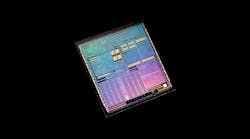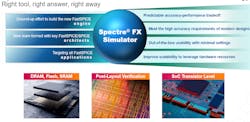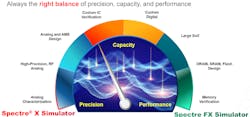Cadence Strikes Back at Synopsys With New Circuit Simulation Tool
Cadence Design Systems is striking back against Synopsys with a new software tool that speeds up simulations that help engineers test new semiconductor blueprints before moving onto production.
The software giant introduced Spectre FX, its next-generation FastSPICE simulation tool. Cadence said the new and scalable architecture at the heart of the Spectre FX provides up to 3X faster performance than rival products with equal or better accuracy, giving customers a boost in productivity (Fig. 1). The tool promises to help engineers speed up the verification process for increasingly intricate memory and system-on-a-chip (SoC) designs.
Today, the most advanced chips combine billions of transistors, and it is impossible for semiconductor engineers to test every single detail in the design of the chip by hand. But failure to find flaws and other unknowns in the design can cause the chip to malfunction or encounter other problems in the future, making simulation software one of the most invaluable tools in every chip engineer's design process.
Semiconductor companies tend to run thousands of simulations to test the most advanced chips—and many of these simulations take hours or days to finish—before sending the final blueprint to a fab.
"You need to run more analog simulations and you need the simulations to run faster," said Jay Madiraju, who works in product management in the Custom IC and PCB business at Cadence, one of the world's top electronic design automation (EDA) software makers. "That's where all vendors try to differentiate themselves by offering as much performance as possible with as much accuracy as possible."
Cadence is also one of the largest players in software based on industry-standard SPICE technology. SPICE is used to create an accurate compute model of analog and other electronic circuits at the level of the transistor and then verify the operation of the circuits. It is also used to spot potential areas of improvement in the IC and identify deficiencies that can sap power efficiency and performance. Chip designers also depend on it to test proposed changes to the blueprint of the chip before prototyping.
Even though SPICE is the semiconductor industry's gold standard in terms of accuracy, FastSPICE is more focused on speed and capacity. These types of tools use advanced partitioning technology and other algorithms to run through hugely complicated systems on a chip, where all the different parts of phones or other devices—and increasingly more of the analog, memory, power, RF, and other chips that have long been scattered around circuit boards (PCBs)—are bundled on the same slab of silicon.
FastSPICE is also used to model the most advanced 3D DRAM—including high-bandwidth memory (HBM)—as well as flash memory (3D NAND and NOR) and on-die embedded memory (SRAM) designs.
FastSPICE technology is also suited for the final verification of the full chip designs. That means giving a final proofread of the finished blueprint of the chip to identify design bugs and other deficiencies. Instead of testing all the different building blocks of the chip separately, FastSPICE technology is used to run tests that string all the components together to make sure that everything will work smoothly.
Another issue on the semiconductor industry’s plate is increased parasitics—the unwanted resistance, inductance, or capacitance that plagues circuits as analog-heavy chips move to smaller and smaller nodes. At more advanced nodes, the analog portions of chips are also more vulnerable to process variations. Ironing out all the potential conflicts caused by these variables is a significant engineering challenge.
All of these factors must be modeled in the final blueprint of the chip and then rigorously tested, which requires huge amounts of computational horsepower housed in data centers or rented out over the cloud.
With the Spectre FX software, Cadence is trying to keep up with the needs of modern chip designers. Cadence said Spectre FX can run on up to 32 CPU cores, placing more parallel compute resources at its disposal to run simulations on memory, analog, and other complex chip designs up to 3X the speed of legacy FastSPICE software tools at around the same level of accuracy and with high capacity.
"I could sacrifice accuracy and give you more performance, but that's not as valuable as keeping the accuracy equal," Madiraju told Electronic Design. "And in some cases, we will offer better accuracy."
Spectre FX gives semiconductor engineers the ability to rapidly check out the timing, functionality, and power of full-chip and subsystem-level designs. It also offers new verification features, including static and dynamic circuit-checking and other analytical tools that are ideal for identifying potential areas of improvement, including subsections of the chip design where excess current leaks out of the circuits.
Cadence said Spectre FX is also engineered for ease of use, with balanced "out-of-the-box" accuracy, capacity, and performance. But customers can also choose between several preset modes that allow them to tune in the accuracy they need—with performance and capacity trade-offs they can tolerate— for different chip designs without dialing in the software by hand. That helps to improve productivity.
"There's no free lunch," Madiraju said. "There is always a trade-off in performance, capacity, and accuracy. But one of the gaps in the market has been the predictability of that trade-off," he said.
Furthermore, the software includes a "save and restore" feature, which allows its customers to take a "snapshot" at any point in the simulation and then run tests from that point instead of starting over, saving precious compute cycles. According to Cadence, the Spectre FX software also incorporates debugging features to pinpoint performance snags in the simulation and determine the root cause.
As the semiconductor industry packs more and more transistors on tiny squares of silicon, Cadence is not alone in upgrading its simulation software. Last month, Synopsys released a new all-in-one suite of simulation software, PrimeSim Continuum, which engineers can use to mix and match SPICE and FastSPICE engines and verify different building blocks of chips in the same software environment.
Synopsys also rolled out its latest FastSPICE architecture, PrimeSim Pro, which is capable of running up to 5X faster than its predecessor in part by taking advantage of massively parallel computing on NVIDIA GPUs.
Spectre FX belongs to Cadence's Spectre product line, giving customers a one-stop shop for simulation tools. The software complements its Spectre X SPICE simulator, which offers up to 10 times more performance on analog, mixed-signal, and other electronic circuits with golden accuracy than its predecessor (Fig. 2). Spectre FX is also tightly integrated with Cadence's Virtuoso ADE product suite to fit into existing workflows.



